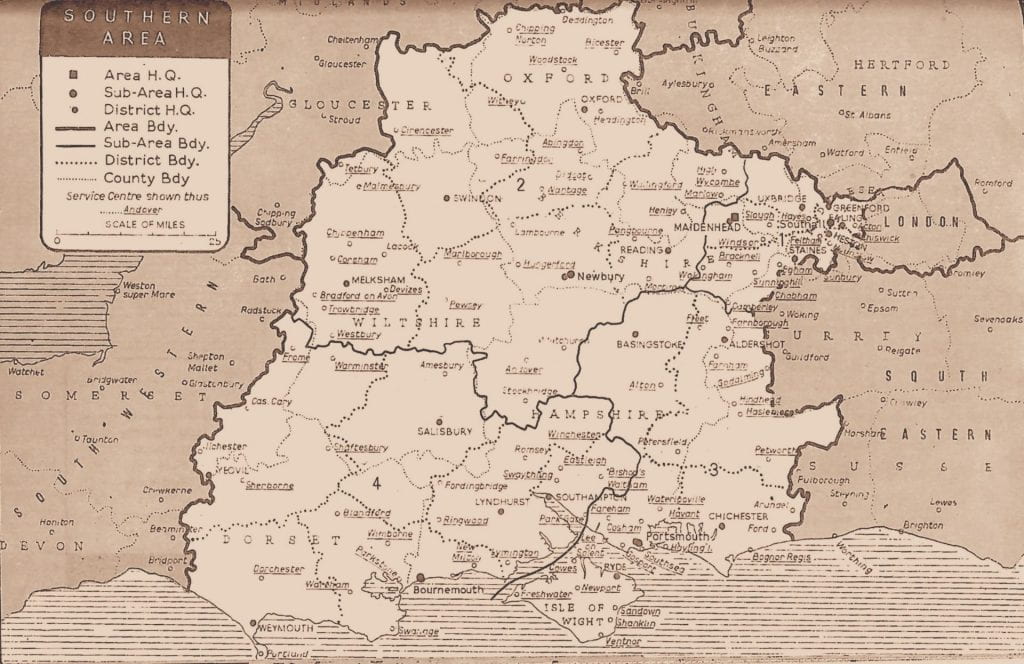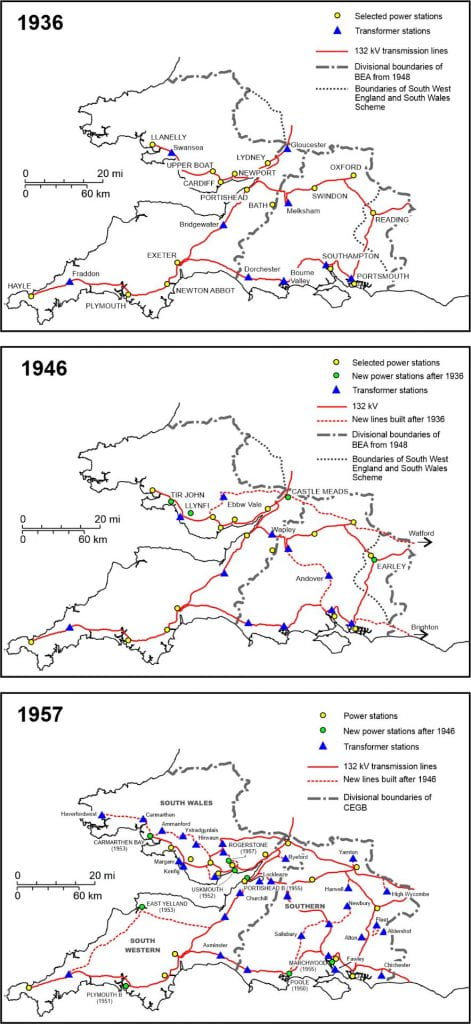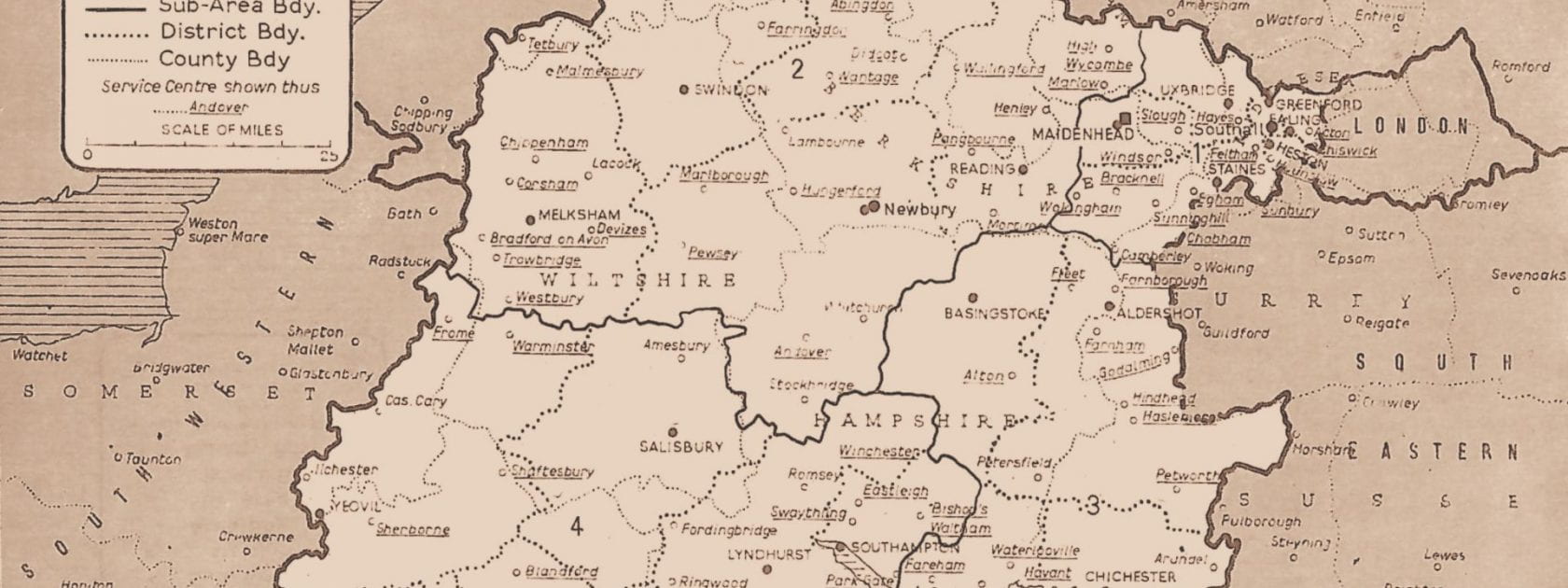After three decades of discussion the whole organisation of electricity was restructured following the Electricity Act 1947. From 1 April 1948, the Southern Electricity Board took over the distribution assets of 22 local authorities and 26 companies (Figure 1). The generating stations and the transmission lines of the Central Electricity Board were transferred to the British Electricity Authority.
Electricity Distribution
The SEB was responsible for integrating the 48 undertakings. Systems had to be standardised and the multiplicity of tariffs reduced. For administrative purposes, the Board area was subdivided four sub-areas and 38 districts.[57] Initially the districts tended to reflect the pre-nationalisation company and municipal areas. The gas works and distribution systems of the six “composite companies” in the SEB are were transferred to the Southern Gas Board on 1 May 1949.[58]
Figure 5 shows the geographical organisation in 1957 when there were four sub-areas and 22 districts. One notable feature is the network of 113 service centres where consumers could pay their bills and purchase appliances.[59] These service centres were an important and profitable part of the Board’s business.

Most parts of the Southern region enjoyed an economic boom after World War II. Slough, for example, which had grown in population from 20,285 in 1921 to 52,590 in 1939, expanded to 66,439 in 1951 and 80,503 in 1961. The New Town being developed at Bracknell had only 5,143 residents in 1951 but had risen to 20,380 a decade later. These developments along with suburban expansion throughout the region all contributed to the rising demand for domestic electricity supply.
Industrial power demands were particularly strong with major new load centres at Heathrow Airport (1946-) and the Esso petroleum refinery at Fawley (1951). The Ministry of Supply and its successor, the UK Atomic Energy Authority was a large consumer at the new establishments at Harwell, Aldermaston and Burghfield. Other military-industrial establishments around Aldershot also contributed to the growing demand for power.
Over the decade 1948/9-1958/9, total sales of electricity in the SEB area grew from 2,338m kWh to 6,255m kWh. The number of consumers expanded from 916,764 to 1,345,855 over the same period. Distribution line construction was a major feature of the Board’s work and the staff increased from 10,557 in March 1949 to 12,621 a decade later.
The work of standardizing systems was still continuing in 1959. Although the number of consumers with only DC supply had been reduced from 40,832 in 1949 to 11,089 in 1959, the number of consumers with non-standard voltages actually increased (from 163,089 in 1949 to 181,385 in 1959).
Electricity Generation and Transmission
The Southern Division of the British Electricity Authority covered the same area as the SEB. It was an amalgamation of the 132kv transmission system developed by the Central Electricity Board and the power stations previously owned by the companies and local authorities. The main tasks from 1948 were to integrate the various generating stations and their workforces, to modernise and standardise operations, and to expand capacity to meet the rapidly growing demand.
Table 7 shows the 26 power stations in the new organisation. They varied in size from large turbine-powered stations at the top to small diesel-engined and hydro units at the bottom. A comparison with Table 4 shows that most of the growth in capacity after 1935/36 had been concentrated at three selected stations—Portsmouth, Southampton and Swindon. One new station at Earley, Reading had been built from 1941-2 to cope with wartime demand. Earley was the only power station owned by the Central Electricity Board; management was contracted to Edmundson’s Electricity.[60]
Table 7 British Electricity Authority Power Stations in the Southern Division 1948/49.
Within a decade, most of the objectives planned in the late 1940s had been fulfilled. Many small stations had been closed, extensions at Portsmouth (30,000kW, 1952) and Cowes (25,000kW, 1955) completed, and two large new stations commissioned at Poole (1950-59) and Marchwood (1955-59). The Marchwood station was the first to be completely designed by the BEA and although planned for coal began with oil firing. Aluminium cladding was used to cover the steel frames of the boiler and turbine houses. This power station was regarded by one architectural critic as “among the most impressive in Europe.”[61] It was a complete contrast to the earlier station at Poole, one of the “brick cathedrals” partly inspired by the Battersea station, an architectural icon of the 1930s.
During the 1950s, Portsmouth and Poole generating stations were served by a fleet of British Electricity Authority colliers. Two of the vessels, “Pompey Power” and “Pompey Light” had been ordered by Portsmouth Corporation in 1947 to ensure a regular coal supply to Gunwharf Road. The other ships, all named after variants of Poole, had been ordered by Coastwise Colliers Ltd and intended to serve the power stations of the County of London Electricity Supply Co.[62]
The original grid transmission system had been extended during the war (Figure 6). A new line from Watford to South Wales connected with the region at Oxford. Portsmouth was linked to Brighton and power demand in the military zone of Wiltshire was reinforced by a 132kv line from the Newbury substation to Melksham with a transformer station at Andover. A submarine cable (33kv) was laid under the Solent in 1943 to provide additional supply to the Isle of Wight. Further cables were laid after the war.[63]

In the 1950s. Salisbury and Newbury were connected to the 132kv grid. The rising demand for industrial power can be seen in the provision of new lines and transformer stations to Farley, Fleet, Aldershot, High Wycombe, Harwell and Yarnton, on the northern outskirts of Oxford.
As the last units were being installed at Marchwood and Poole in 1958/59, much larger machines were now in service at new stations in the coalfield area of the East Midlands.[64] Plans made earlier for a more integrated national system were now taking shape—much larger coal-fired stations, new generating technology in the form of nuclear reactors and high-capacity 275kv Supergrid (later raised to 400kv).
Melksham became an important switching and transformer station on the Supergrid and was linked northwards to the Midlands, eastwards across the Berkshire Downs to West Waeybridge with a branch to Fleet near Aldershot and with planned extensions to South Wales and to Exeter via a nuclear station at Hinckley Point.
Table 8 Central Electricity Generating Board Power Stations in the Southern Division 1958/59.
Although no commercial nuclear stations were built in the region, a site at Hamstead, near Yarmouth on the Isle of Wight, had been considered as a possibility.[65] Winfrith Heath, Dorset was chosen by the UK Atomic Energy Authority as the site for a research centre for work on experimental reactors. The first reactor was completed in late 1959 on the 1,300-acre site.
During the first decade of operation the Southern Division built two new power stations and raised generating capacity from 435,688kW to 1,226,444kW (Table 8). The transmission line capacity was raised from ?? to 893 route miles, of which 137 route miles were part of the 275kv Supergrid. Over the period the numbers employed rose from 1,918 to 3,062.
From January 1958, when the Central Electricity Generating Board took over from the Central Electricity Authority, there were changes in the administrative structure. A new South Western Region was established incorporating the Southern, South Western and South Wales Divisions. Under the new arrangements the regional director in Bristol became responsible for the higher-order planning and administration of 43 power stations, 1,768 miles of transmission lines and 8,979 employees. The divisional offices in High Street, Portsmouth[66] not only lost some administrative roles but design work was transferred to new project groups outside the region.
[57] Southern Electricity Board, First Annual Report 1948-49 (HMSO 1949). Parliamentary Paper Session 1948-49, HC 339.
[58] The Electricity Act 1947, Schedule II, Part II listed 12 composite gas and electricity companies.
[59] Electricity Supply Handbook 1958 (London: Electrical Times, 1958), pp.86-91.
[60] “Earley Power Station”,The Engineer Vol.175, 1945, p.154.
[61] G.E. Kidder Smith, The new architecture of Europe (London: Prentice-Hall International, 1961), pp.58-59.
[62] D.R. Chesterton and R.S. Fenton, Gas and Electricity Colliers (Kendal: World Ship Society, 1984), pp.89-91.[63] Ian Sherfield, Electric Wight (2012), pp.40-44.
[64] Castle Donington had 100,000kW units from 1956 and the first 200,000kW turbine was installed at High Marnham in 1959.
[65] Ian Sherfield, Electric Wight (2012), p.47.
[66] The building previously used as offices by the Corporation Electricity Department was known as The Governor’s House, High Street. Until the 1880s it had been the official residence of the military governor of Portsmouth. The 1860 (Old Portsmouth) project. See: historyinportsmouth.co.uk


